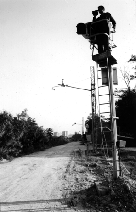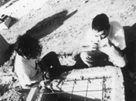









FRACTILE ORGANIZATION
THE ABANDONMENT
The attempt at defining and controlling the entire territory, mirage of our western culture, just when it seemed most likely to realize itself, gives forth its first water. The first cracks have opened in the very hearts of our system: the large cities. The forest that at one time surrounded cities and villages, where bears and wolves, but also the nightmares would hide, where the fantasies and the very idea of liberty itself were shoved far from the city, put into the corners, restricted and in an unbelievable act of clemency, protected. And here it is now that that same forest rises again, exactly there in the cities where the territory's systems of appropriation and control are most ancient and crumbling. Given the impossibility of total human control, the cement under which the forests were covered has cracked open, the earth flowers in new and unpredictable forms, preparing to contest with its human occupants the domination of space, from the scrap-heaps and beyond. To forecast the unforecastable, to save the coming into being of the "Actual Territories," means to abandon them. For abandonment is the maximum form of a cure for that which has developed outside human will and plan.
THE PROJECT
To intervene on a territory is not merely an act of planning but an act of creation, an attempt to assemble contradictions and transform them into poetic relationships: ultimately one is more attentive to modifying how space is perceived than the way space itself exists.
homes
On foot establishes an unmediated experience, allowing for a more dynamic reading. A nomadic research, a mode of capturing the act of crossing without regimentation, ratification or definition of the object examined, so as not to prevent its becoming. Crossing is for Stalker a creative act, that means creating a system of relations within the chaotic juxtaposition of time and space that characterizes "Actual Territories." Crossing means composing in a single conscious parcours the strident contradictions that animate these spaces, in a search for unedited harmony. Crossings and making crossings, inducing into the perception of the actual because it can become diffused into the general consciousness, while avoiding, however, banalizing its linguistic meaning.
Is a collective subject that engages research and actions within the landscape with particular attention to the areas around the city's margins and forgotten urban space, and abandoned areas or regions under transformation. These investigations are conducted across several levels, around notions of practicality, representations and interventions on these spaces that are referred to here as "Actual Territories." Stalker is together custodian, guide and artist for these "Actual Territories." In the multiple roles we are disposed to confront at once the apparently unsolvable contradictions of salvaging through abandonment, of representation through sensorial perception, of intervening within the unstable and mutable conditions of these areas.
constitute the built city's negative, the interstitial and the marginal, spaces abandoned or in the process of transformation. These are the removed lieu de la memoirs, the unconscious becoming of the urban systems, the spaces of confrontation and contamination between the organic and the inorganic, between nature and artifice. Here the metabolization of humanity's discarded scrap, or nature's detritus, produces a new horizon of unexplored territories, mutant and by default virgin, that are for Stalker "Actual Territories." The term "actual" indicates the process in which space comes into being. The "actual" is not what we are, but rather that we are becoming, that is to say the "other" that becomes other (Foucault). Such territories are difficult to render intelligible and therefore projectable, because they lack connections to the present and therefore are extraneous to contemporary language. Their conscious presence cannot come about by direct experience, they are to be physically witnessed rather than represented. The archive of experiences is the only form of mapping possible for these "Actual Territories."
Perceiving the discarded territories, in completing such a route, between that which is secure, quotidian, and that which is uncertain, generates a sense of dislocation, a state of apprehension. This altered state induces a perceptual intensification unexpectedly giving the space a meaning, making "everywhere" a place for discovery, or instead a dreaded place for an undesirable encounter. The gaze becomes penetrating, the ear becomes keen to every sound.
Stalker experiments on the urban agglomerate as if it were a grand cognitive map that is updated continuously through each crossing. The city's stain-like shape finds analogies to representations of the human mind. The human mind is neither a unity, nor a structure organized according to a given hierarchy; it is an ensemble of separate capacities, frequently localized in specific regions of the brain (G. Jervis). It is interesting to observe how these images have in common a problem with the patterns of localization of different realities that live separately by different conditions, of which the links and the connections are created by routes. To gather these realties presupposes measuring oneself within a dynamic mode in movement. A movement capable of sectioning the design of this "landscape" in thousands of possible routes each of them different from another, without every passing through the center.


